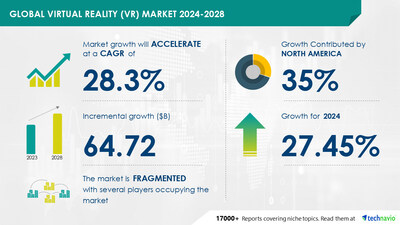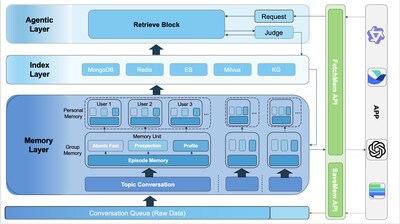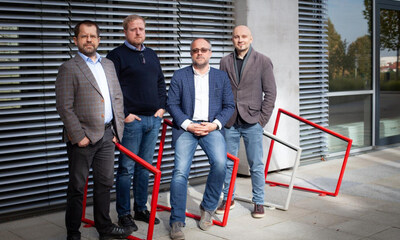Virtual Reality (VR) Market size is set to grow by USD 64.72 billion from 2024-2028, Recent developments in virtual reality technologies to boost the market growth, Technavio
Press Releases
May 24, 2024
NEW YORK, May 24, 2024 /PRNewswire/ — The global virtual reality (vr) market size is estimated to grow by USD 64.72 billion from 2024-2028, according to Technavio. The market is estimated to grow at a CAGR of 28.3% during the forecast period.
For more insights on the forecast market size and historic data (2018 – 2022) – Download Free sample report in minutes
|
Forecast period |
2024-2028 |
|
Base Year |
2023 |
|
Historic Data |
2018 – 2022 |
|
Segment Covered |
End-user (Enterprise and Consumer), Component (Hardware and Software), and Geography (North America, APAC, Europe, Middle East and Africa, and South America) |
|
Region Covered |
North America, APAC, Europe, Middle East and Africa, and South America |
|
Key companies profiled |
3D Systems Corp., Advanced Micro Devices Inc., Alphabet Inc., Apple Inc., Baidu Inc., DPVR, HTC Corp., Lenovo Group Ltd., Meta Platforms Inc., Microsoft Corp., Osso VR Inc., Pico Technology Ltd., Samsung Electronics Co. Ltd., Sony Group Corp., StarVR Corp., Unity Software Inc., Valve Corp., Varjo Technologies Oy, Virtuix Inc., and FOVE Inc. |
Key Market Trends Fueling Growth
The virtual reality (VR) market is experiencing significant growth through the integration of artificial intelligence (AI) and machine learning (ML). This fusion of technologies is revolutionizing industries, including healthcare, education, gaming, and simulation. In healthcare, AI and ML algorithms analyze medical data for accurate diagnoses and treatment plans, while VR simulations offer immersive training for complex procedures. The commercial, hardware, and software segments, as well as the automotive, entertainment, and architecture sectors, are also benefiting from VR technology’s advancements.
Amidst the coronavirus outbreak and pandemic crisis, live virtual entertainment, VR simulators, and virtual theme parks are providing unique experiences. The REAL Immersive System, AI applications, and 3D virtual worlds are shaping the metaverse, with VR headsets, gloves, and bodysuits enhancing user experience. Instructional training for pilots, defense personnel, technicians, and mental health issues are also being addressed through virtual platforms, meetings, and policies & strategies.
Market Challenges
- The global virtual reality (VR) market has faced substantial hindrances due to the high cost of immersive hardware. This financial barrier has impeded accessibility and utilization across various industries, including healthcare, gaming, automotive, entertainment, and organizations. Consumers and enterprises have been challenged by the substantial investment required for high-quality VR experiences, with premium headsets like Meta Quest 2 and HTC Vive costing around USD399 to USD599.
- The VR hardware segment, including VR headsets, glasses, gloves, and bodysuits, has significantly impacted the market’s expansion and adoption in the commercial, non-immersive, and planning sectors. The pandemic crisis has further highlighted the need for virtual platforms in sectors like education, mental health, and virtual theme parks, emphasizing the importance of addressing the affordability issue in the VR market.
Research report provides comprehensive data on impact of trend, driver and challenges – Download Free sample report in minutes
Segment Overview
- End-user
- 1.1 Enterprise
- 1.2 Consumer
- Component
- 2.1 Hardware
- 2.2 Software
- Geography
- 3.1 North America
- 3.2 APAC
- 3.3 Europe
- 3.4 Middle East and Africa
- 3.5 South America
1.1 Enterprise- The virtual reality (VR) market can be segmented by end-user into various industries, including the planning sector, healthcare, gaming, automotive, entertainment, organizations, and architecture. In the planning sector, PropVR technology is utilized for creating immersive virtual environments for urban planning and architectural design. The non-immersive segment caters to commercial applications, such as virtual platforms for meetings, policies & strategies, and event organizers. The commercial segment encompasses VR applications in entertainment, including live virtual entertainment, VR simulators, and virtual theme parks.
The hardware segment includes VR technology advancements, such as REAL Immersive System, AI applications, and the Metaverse, which are driving the adoption of VR headsets, glasses, gloves, and bodysuits. The software segment focuses on instructional training, with applications in industries like aviation for pilots and defense personnel, as well as for addressing mental health issues. The coronavirus outbreak and pandemic crisis have accelerated the need for virtual solutions, leading to increased demand for VR technology in various sectors. Key applications include VR technology in gaming, with platforms like PlayStation and Xbox, and in the healthcare industry for therapeutic purposes.
For more information on market segmentation with geographical analysis including forecast (2024-2028) and historic data (2018 – 2022) – Download a Sample Report
Research Analysis
The Virtual Reality (VR) market is experiencing exponential growth, with various industries embracing this technology for instructional training, entertainment, and simulation purposes. VR headsets and glasses are the primary devices used to immerse users in a 3D virtual world. VR gloves and bodysuits further enhance the experience by allowing for interactive and full-body engagement. VR simulators are utilized in sectors like healthcare, pilots training, automotive, and gaming to provide realistic and immersive experiences.
AI applications are also integrated into VR systems to enhance user interaction and customization. The Metaverse, a collective virtual shared space, is the future of VR, offering limitless possibilities for exploration and social interaction. VR technology is revolutionizing industries, from gaming giants like PlayStation and Xbox to healthcare and automotive sectors. REAL Immersive System and virtual theme parks are other exciting applications of VR technology, providing users with truly immersive experiences.
Market Research Overview
The Virtual Reality (VR) market is a rapidly growing industry that utilizes technology to create immersive, interactive environments. VR headsets and glasses transform the user’s perspective, providing a three-dimensional experience. Technologies such as haptic feedback and motion tracking add to the realism. VR applications span various sectors, including education, healthcare, and entertainment. In the education sector, VR offers interactive learning experiences.
In healthcare, it’s used for training and therapy. In entertainment, VR provides immersive gaming and movie experiences. The market is driven by advancements in technology and increasing consumer demand. The future of VR lies in its ability to create more realistic and interactive experiences. VR also offers potential in areas like remote work and virtual tourism. The market is projected to grow significantly in the coming years.
Table of Contents:
1 Executive Summary
2 Market Landscape
3 Market Sizing
4 Historic Market Size
5 Five Forces Analysis
6 Market Segmentation
- End-user
- Enterprise
- Consumer
- Component
- Hardware
- Software
- Geography
- North America
- APAC
- Europe
- Middle East And Africa
- South America
7 Customer Landscape
8 Geographic Landscape
9 Drivers, Challenges, and Trends
10 Company Landscape
11 Company Analysis
12 Appendix
About Technavio
Technavio is a leading global technology research and advisory company. Their research and analysis focuses on emerging market trends and provides actionable insights to help businesses identify market opportunities and develop effective strategies to optimize their market positions.
With over 500 specialized analysts, Technavio’s report library consists of more than 17,000 reports and counting, covering 800 technologies, spanning across 50 countries. Their client base consists of enterprises of all sizes, including more than 100 Fortune 500 companies. This growing client base relies on Technavio’s comprehensive coverage, extensive research, and actionable market insights to identify opportunities in existing and potential markets and assess their competitive positions within changing market scenarios.
Contacts
Technavio Research
Jesse Maida
Media & Marketing Executive
US: +1 844 364 1100
UK: +44 203 893 3200
Email: [email protected]
Website: www.technavio.com/
![]() View original content to download multimedia:https://www.prnewswire.com/news-releases/virtual-reality-vr-market-size-is-set-to-grow-by-usd-64-72-billion-from-2024-2028–recent-developments-in-virtual-reality-technologies-to-boost-the-market-growth-technavio-302154225.html
View original content to download multimedia:https://www.prnewswire.com/news-releases/virtual-reality-vr-market-size-is-set-to-grow-by-usd-64-72-billion-from-2024-2028–recent-developments-in-virtual-reality-technologies-to-boost-the-market-growth-technavio-302154225.html
SOURCE Technavio





